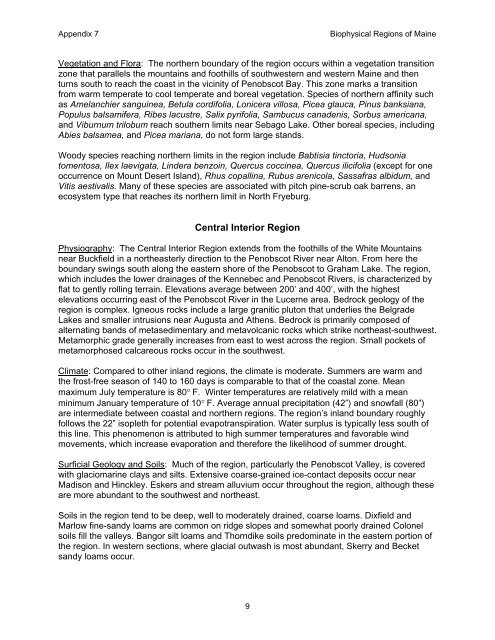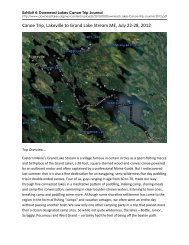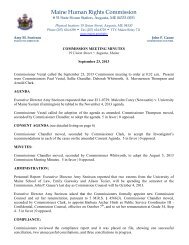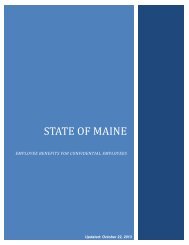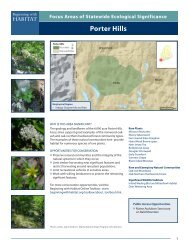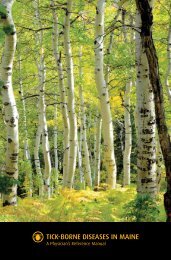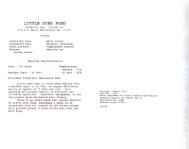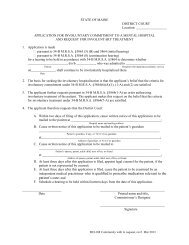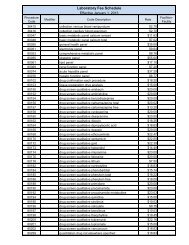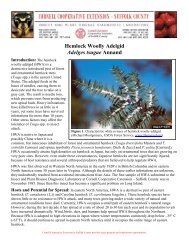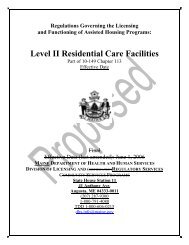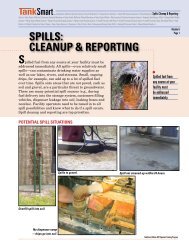BIOPHYSICAL REGIONS - Maine.gov
BIOPHYSICAL REGIONS - Maine.gov
BIOPHYSICAL REGIONS - Maine.gov
Create successful ePaper yourself
Turn your PDF publications into a flip-book with our unique Google optimized e-Paper software.
Appendix 7 Biophysical Regions of <strong>Maine</strong><br />
Vegetation and Flora: The northern boundary of the region occurs within a vegetation transition<br />
zone that parallels the mountains and foothills of southwestern and western <strong>Maine</strong> and then<br />
turns south to reach the coast in the vicinity of Penobscot Bay. This zone marks a transition<br />
from warm temperate to cool temperate and boreal vegetation. Species of northern affinity such<br />
as Amelanchier sanguinea, Betula cordifolia, Lonicera villosa, Picea glauca, Pinus banksiana,<br />
Populus balsamifera, Ribes lacustre, Salix pyrifolia, Sambucus canadenis, Sorbus americana,<br />
and Viburnum trilobum reach southern limits near Sebago Lake. Other boreal species, including<br />
Abies balsamea, and Picea mariana, do not form large stands.<br />
Woody species reaching northern limits in the region include Babtisia tinctoria, Hudsonia<br />
tomentosa, Ilex laevigata, Lindera benzoin, Quercus coccinea, Quercus ilicifolia (except for one<br />
occurrence on Mount Desert Island), Rhus copallina, Rubus arenicola, Sassafras albidum, and<br />
Vitis aestivalis. Many of these species are associated with pitch pine-scrub oak barrens, an<br />
ecosystem type that reaches its northern limit in North Fryeburg.<br />
Central Interior Region<br />
Physiography: The Central Interior Region extends from the foothills of the White Mountains<br />
near Buckfield in a northeasterly direction to the Penobscot River near Alton. From here the<br />
boundary swings south along the eastern shore of the Penobscot to Graham Lake. The region,<br />
which includes the lower drainages of the Kennebec and Penobscot Rivers, is characterized by<br />
flat to gently rolling terrain. Elevations average between 200’ and 400’, with the highest<br />
elevations occurring east of the Penobscot River in the Lucerne area. Bedrock geology of the<br />
region is complex. Igneous rocks include a large granitic pluton that underlies the Belgrade<br />
Lakes and smaller intrusions near Augusta and Athens. Bedrock is primarily composed of<br />
alternating bands of metasedimentary and metavolcanic rocks which strike northeast-southwest.<br />
Metamorphic grade generally increases from east to west across the region. Small pockets of<br />
metamorphosed calcareous rocks occur in the southwest.<br />
Climate: Compared to other inland regions, the climate is moderate. Summers are warm and<br />
the frost-free season of 140 to 160 days is comparable to that of the coastal zone. Mean<br />
maximum July temperature is 80° F. Winter temperatures are relatively mild with a mean<br />
minimum January temperature of 10° F. Average annual precipitation (42”) and snowfall (80”)<br />
are intermediate between coastal and northern regions. The region’s inland boundary roughly<br />
follows the 22” isopleth for potential evapotranspiration. Water surplus is typically less south of<br />
this line. This phenomenon is attributed to high summer temperatures and favorable wind<br />
movements, which increase evaporation and therefore the likelihood of summer drought.<br />
Surficial Geology and Soils: Much of the region, particularly the Penobscot Valley, is covered<br />
with glaciomarine clays and silts. Extensive coarse-grained ice-contact deposits occur near<br />
Madison and Hinckley. Eskers and stream alluvium occur throughout the region, although these<br />
are more abundant to the southwest and northeast.<br />
Soils in the region tend to be deep, well to moderately drained, coarse loams. Dixfield and<br />
Marlow fine-sandy loams are common on ridge slopes and somewhat poorly drained Colonel<br />
soils fill the valleys. Bangor silt loams and Thorndike soils predominate in the eastern portion of<br />
the region. In western sections, where glacial outwash is most abundant, Skerry and Becket<br />
sandy loams occur.<br />
9


